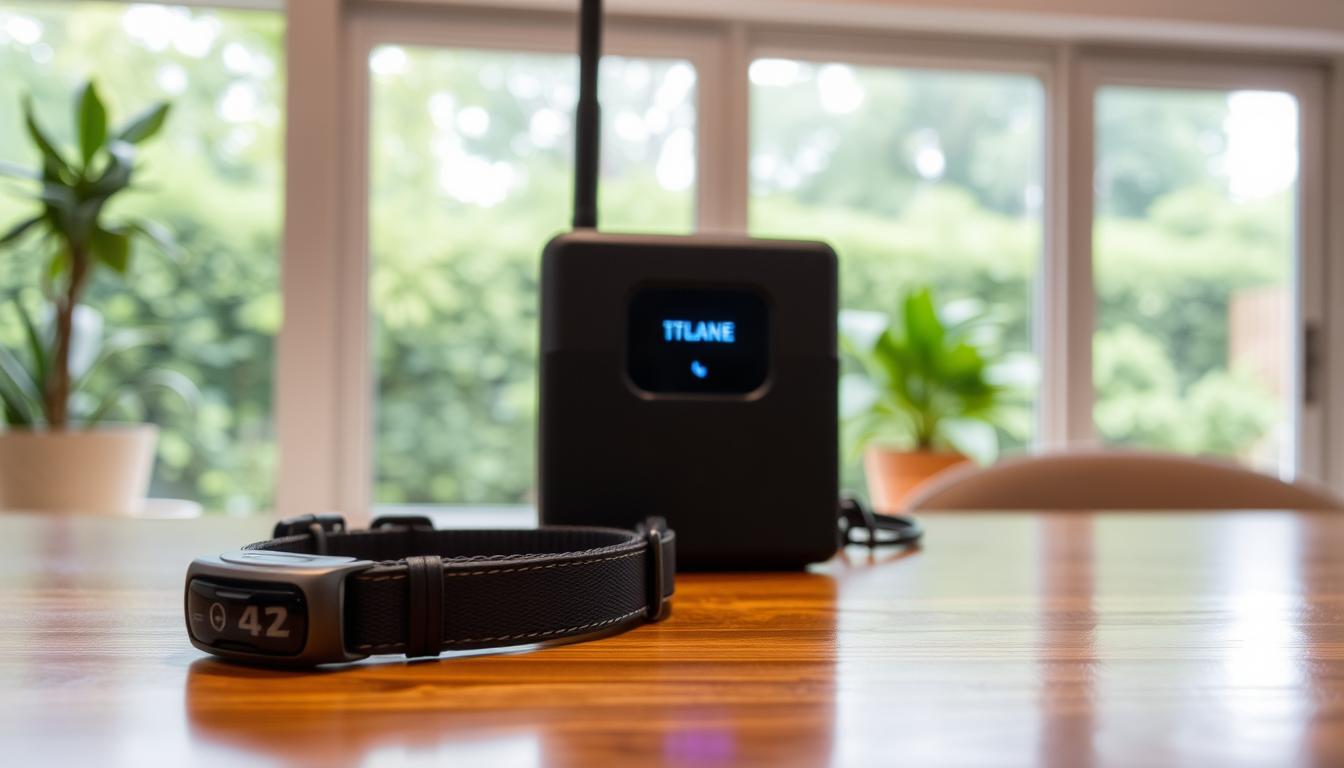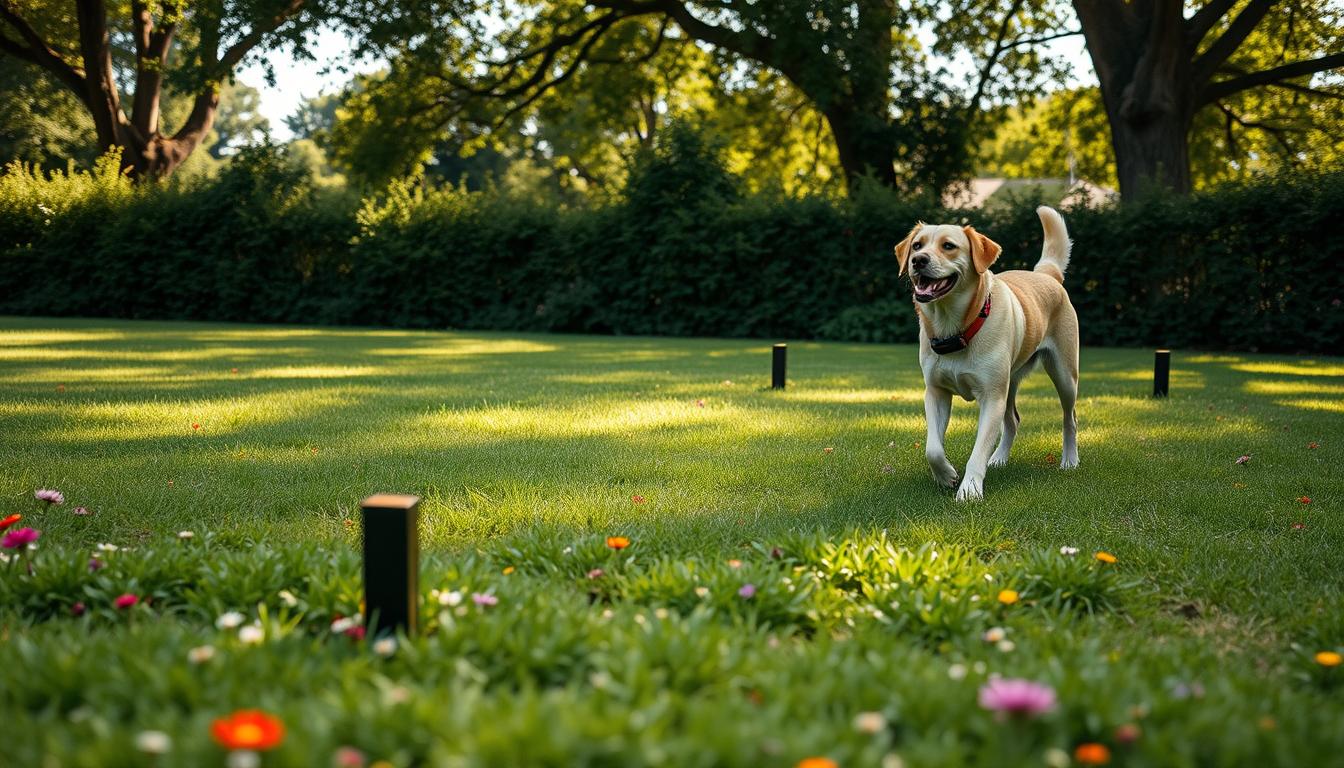As a pet owner, ensuring your dog’s safety is a top priority. Traditional containment methods are being replaced by advanced GPS pet systems that offer both boundary control and real-time location tracking. Modern wireless dog fences provide greater flexibility and security, allowing your pets to roam freely within designated boundaries.
By integrating GPS tracking technology with wireless fencing, you can create an ultimate pet safety solution. This innovative approach not only keeps your pets secure but also gives you peace of mind. With the evolution of pet containment, you can now choose from a variety of top-notch GPS tracking and wireless fence combinations available in the market today.
Key Takeaways
- Understand how combining GPS tracking with wireless fencing enhances pet safety.
- Learn about the benefits of modern GPS pet systems over traditional containment methods.
- Discover the top GPS tracking and wireless fence combinations for your pets.
- Explore the flexibility and security offered by wireless dog fences.
- Find out how GPS tracking technology provides real-time location tracking.
Understanding GPS Pet Systems
Understanding how GPS pet systems work is crucial for dog owners who value freedom and safety for their pets. GPS dog fences are among the most innovative pet tech trends, offering a significant upgrade over traditional fencing methods.
What Are GPS Dog Fences?
GPS dog fences are virtual boundary systems that don’t require physical barriers or buried wires. They usesatellite technologyto create invisible boundaries that can be customized through smartphone applications. The basic components of a GPS pet system include the collar device, the receiver, and the control mechanism, usually an app.
| Component | Description |
|---|---|
| Collar Device | Worn by the dog, it receives GPS signals and communicates with the receiver. |
| Receiver | Connected to the internet, it helps in tracking the dog’s location. |
| Control Mechanism (App) | Allows owners to set boundaries and monitor their dog’s location. |
How GPS Pet Tracking Works
GPS tracking works by triangulating your pet’s position using satellite signals to provide real-time location data. Unlike traditional invisible fences that use buried wires, modern GPS-based systems offer greater flexibility and coverage areas. GPS pet tracking can monitor your dog’s location both within and outside established boundaries, providing an extra layer of security.
By leveragingGPS technology, dog owners can ensure their pets are safe and contained without the need for physical fences. This not only provides peace of mind but also gives dogs the freedom to move around within designated areas.
Benefits of Combining GPS Tracking with Wireless Dog Fences
Combining GPS tracking with wireless dog fences offers a comprehensive solution for pet owners seeking to ensure their dog’s safety. This integrated system not only contains your pet within designated boundaries but also allows you to track their location if they escape.
Enhanced Safety Features
The combined system boasts enhanced safety features, including real-time alerts when your dog approaches or breaches the set boundaries. This feature is particularly useful for preventing potential dangers such as traffic accidents or confrontations with other animals.
- Customizable boundaries to fit your property’s shape and size
- Real-time tracking to locate your dog if they escape
- Alerts for boundary breaches or when your dog enters restricted areas
Freedom and Peace of Mind
With a GPS tracking and wireless fencing system, you can give your dog more freedom to roam within a safe, defined area. This not only improves your dog’s quality of life but also gives you peace of mind, knowing that your pet is safe and contained.
The flexibility of wireless dog fences means you can adjust the boundaries as needed, making it ideal for homes with changing yard layouts or for pet owners who travel with their pets.
Key Features to Look for in GPS Pet Systems
When selecting a GPS pet system, it’s crucial to consider several key features that ensure your pet’s safety and your peace of mind. A reliable GPS pet system should offer a combination of accuracy, long battery life, and customizable boundaries.
GPS Accuracy and Coverage
GPS accuracy is critical for precise location tracking. Look for systems that connect to multiple satellites, such as the Halo Collar, which relies on signals from over 150 satellites. This ensures accurate location details even in challenging environments. Multi-satellite connectivity is a key feature to look for.
Battery Life
Battery life is another crucial factor, as it determines how long your pet can be tracked without recharging. Different systems offer varying battery life, ranging from 10 hours to 7 days. Consider your pet’s needs and your lifestyle when choosing a system.
Customizable Boundaries
Advanced GPS systems allow for customizable boundaries, enabling you to create complex shapes, multiple zones, and adjustable perimeters. This feature is particularly useful for pet owners with large or irregularly shaped properties.
| Feature | Description | Importance |
|---|---|---|
| GPS Accuracy | Precise location tracking using multiple satellites | High |
| Battery Life | Duration between recharges | High |
| Customizable Boundaries | Ability to create complex boundary shapes and zones | Medium |
Additional features worth considering include waterproof design, adjustable correction levels, and integration with smartphone apps for real-time monitoring. Some systems also use AI and machine learning to improve accuracy and predict your pet’s movements before they reach boundaries.
How to Choose the Right GPS Fence for Your Dog
To ensure your dog’s safety, it’s crucial to choose a GPS fence that suits your property and pet. Several factors come into play when making this decision.
Property Size Considerations
When selecting a GPS dog fence, one of the primary considerations is the size of your property. Many GPS fence systems require a minimum area to function properly, often at least 1/2 acre. Assess your yard size to ensure the system you choose can accommodate it.
Dog Size and Temperament
Your dog’s size, weight, and neck measurements are also crucial. Many GPS dog fences have specific requirements, such as collars that fit dogs with necks from 8-30.5 inches. Consider your dog’s temperament as well; some may respond better to certain correction types (tone, vibration, static) than others.
Environmental Factors
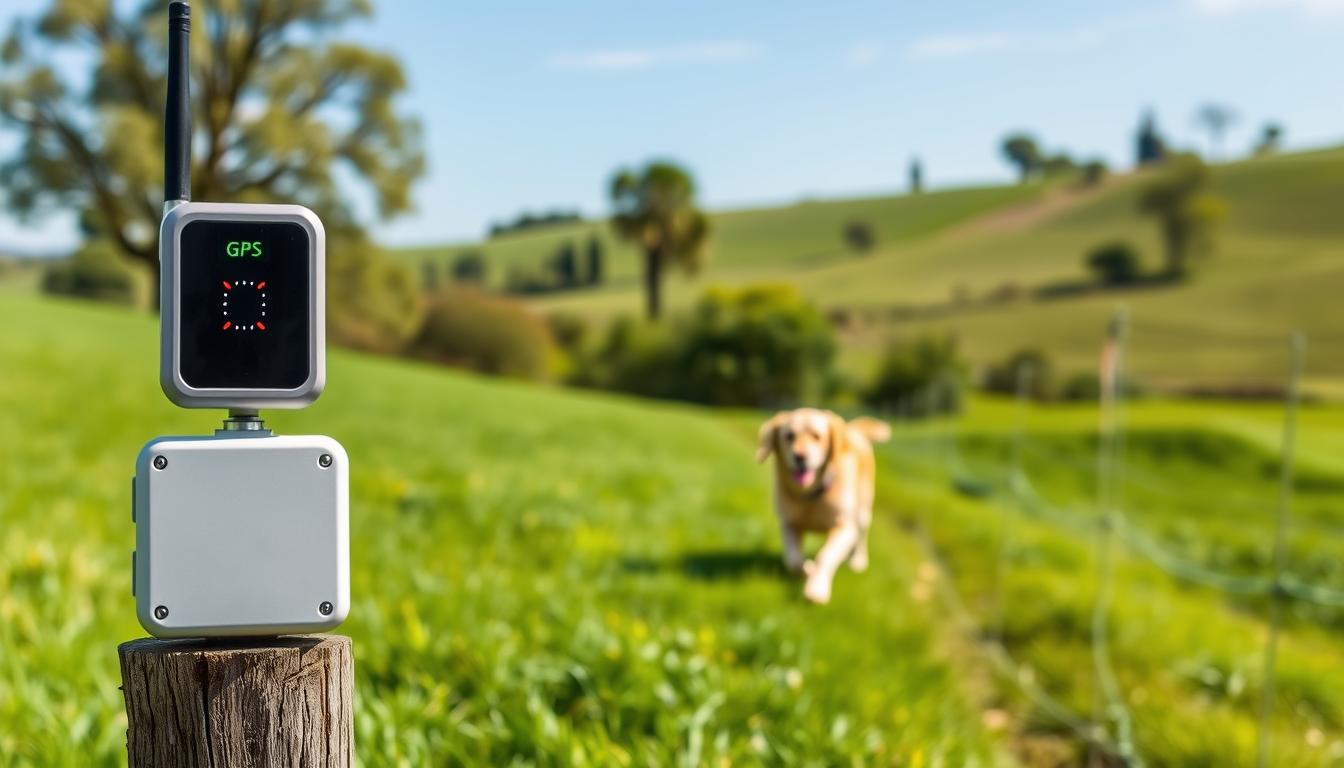 Environmental factors like tree coverage, buildings, and terrain can affect GPS signal strength. While some systems may not be recommended for areas with dense tree coverage, others have proven effective despite such conditions. “It’s essential to consider these factors to ensure the GPS fence works effectively,” as noted by a satisfied user.
Environmental factors like tree coverage, buildings, and terrain can affect GPS signal strength. While some systems may not be recommended for areas with dense tree coverage, others have proven effective despite such conditions. “It’s essential to consider these factors to ensure the GPS fence works effectively,” as noted by a satisfied user.
Top 5 GPS Dog Fence Systems for Ultimate Pet Safety
To help you make an informed decision, we’ve evaluated the top 5 GPS dog fence systems that prioritize ultimate pet safety. These systems offer a range of features, including GPS tracking, containment, and alerts, to ensure your dog’s safety.
Selection Criteria
Our selection criteria included reliability, accuracy, ease of use, customer reviews, and overall value. We considered factors such as GPS signal strength, battery life, and customizable boundaries to determine the top systems.
Price Range Comparison
The prices for these GPS dog fence systems vary, ranging from around $140 for budget-friendly options like Tractive to over $800 for premium solutions like the Halo Collar 4 GPS Dog Fence. Here’s a comparison of the top 5 systems:
| System | Price | Subscription Cost |
|---|---|---|
| Halo Collar 4 GPS Dog Fence | $799 | $29.99/month |
| Guardian GPS 2.0 Dog Fence + Tracking | $699 | $19.99/month |
| SATELLAI Collar | $499 | $9.99/month |
| SpotOn GPS Fence Collar | $599 | $7.99/month |
| Tractive | $139 | $8/month |
When choosing a GPS dog fence system, consider the balance between features and cost. While premium systems offer advanced features, budget-friendly options can still provide reliable tracking and containment.
Halo Collar 4 GPS Wireless Dog Fence
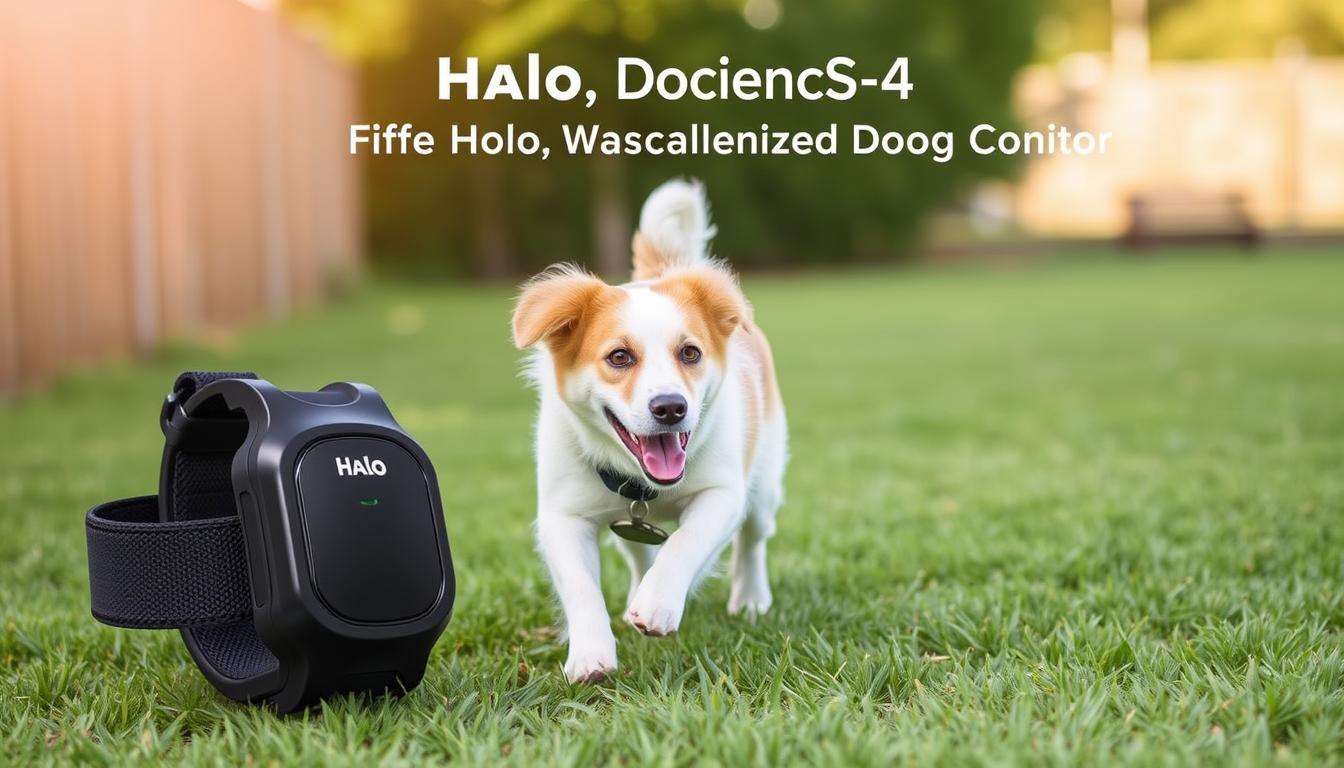
For dog owners seeking ultimate pet safety, the Halo Collar 4 GPS Wireless Dog Fence stands out as a top choice. Co-founded by dog behavior expert Cesar Millan, this system has evolved to become even better with its latest iteration.
Overview
The Halo Collar 4 is a market-leading GPS wireless dog fence that offers advanced features for pet safety. With its ability to create and store unlimited virtual fences, it provides dog owners with peace of mind. The system utilizes dual-frequency GPS with 1-second tracking, ensuring that your dog’s location is always up-to-date.
Key Features
The Halo Collar 4 boasts several key features, including a 30-hour battery life and smart roaming between Bluetooth, Wi-Fi, and LTE for optimized performance. It also offers customizable correction options, with three levels of positive encouragement feedback and three levels of prevention feedback. The collar is designed to accommodate dogs with neck sizes from 8-30.5″ with its adjustable Perfect Fit sizing.
Pros
The Halo Collar 4 has several advantages, including its waterproof design and comprehensive training program. The collar is available in four color options: Sunburst, Graphite, Orchid, and Midnight Blue. Additionally, it comes with a 100% satisfaction guarantee, providing confidence for buyers.
Cons
While the Halo Collar 4 offers many benefits, it requires a subscription for its services. Moreover, the proprietary magnetic charging device might be inconvenient if lost or damaged.
Guardian GPS 2.0 Dog Fence + Tracking
![]()
PetSafe’s Guardian GPS2.0 Dog Fence + Tracking offers a robust solution for pet owners seeking to ensure their dog’s safety. This system boasts advanced real-time tracking and customizable virtual boundaries, making it a top contender in the GPS dog fence market.
Overview
The Guardian GPS2.0 Dog Fence + Tracking is a well-designed system from a well-established pet safety brand. It features AccuGuard™ technology, which uses AI to predict your dog’s movements and provide enhanced boundary accuracy.
Key Features
This system allows you to create and store up to 50 unique virtual fences, making it versatile for home use and travel. The collar also boasts an impressive battery life of up to 70 hours on a single charge, with quick recharging in just 2-4 hours.
Pros
The Guardian GPS2.0 Dog Fence + Tracking offers several benefits, including real-time GPS tracking, customizable correction options (tone, vibration, and 10 levels of static), and the fact that Wi-Fi is only needed for initial setup and updates. Additionally, the collar is now 50% smaller and lighter than competitors, fitting 98% of dog breeds with neck sizes 8″ and up.
Cons
While the Guardian GPS2.0 Dog Fence + Tracking is a robust system, it does have some limitations. These include a property size requirement (minimum 1/2 acre), subscription requirement for tracking features, and potential limitations in areas with dense tree coverage.
SATELLAI Collar

The SATELLAI Collar is revolutionizing pet containment with its cutting-edge technology. Unveiled at CES 2025, this innovative GPS dog collar combines satellite connectivity with artificial intelligence to offer unparalleled precision and reliability, even in the most remote areas.
Overview
The SATELLAI Collar is a groundbreaking new addition to the pet containment market. It utilizes a dual-antenna system and multi-constellation satellite positioning to maintain accurate tracking, ensuring your dog remains safe and within designated boundaries.
Key Features
This advanced collar allows you to create and manage complex virtual fences, including nested and overlapping boundaries covering areas up to 100,000 acres. Additionally, it features health monitoring capabilities that track your dog’s activity levels and provide suggestions to maintain optimal condition.
Pros
The SATELLAI Collar boasts an impressive 7-day battery life and an IP68 waterproof rating, ensuring durability in various environments. You can also create unlimited virtual fences and benefit from flexible correction options, including sound, vibration, and voice commands. The battery recharges in just 2 hours.
Cons
While the SATELLAI Collar offers numerous benefits, it requires a subscription for GPS tracking features. Additionally, it may not be suitable for small-breed dogs like Chihuahuas due to size constraints.
SpotOn GPS Fence Collar
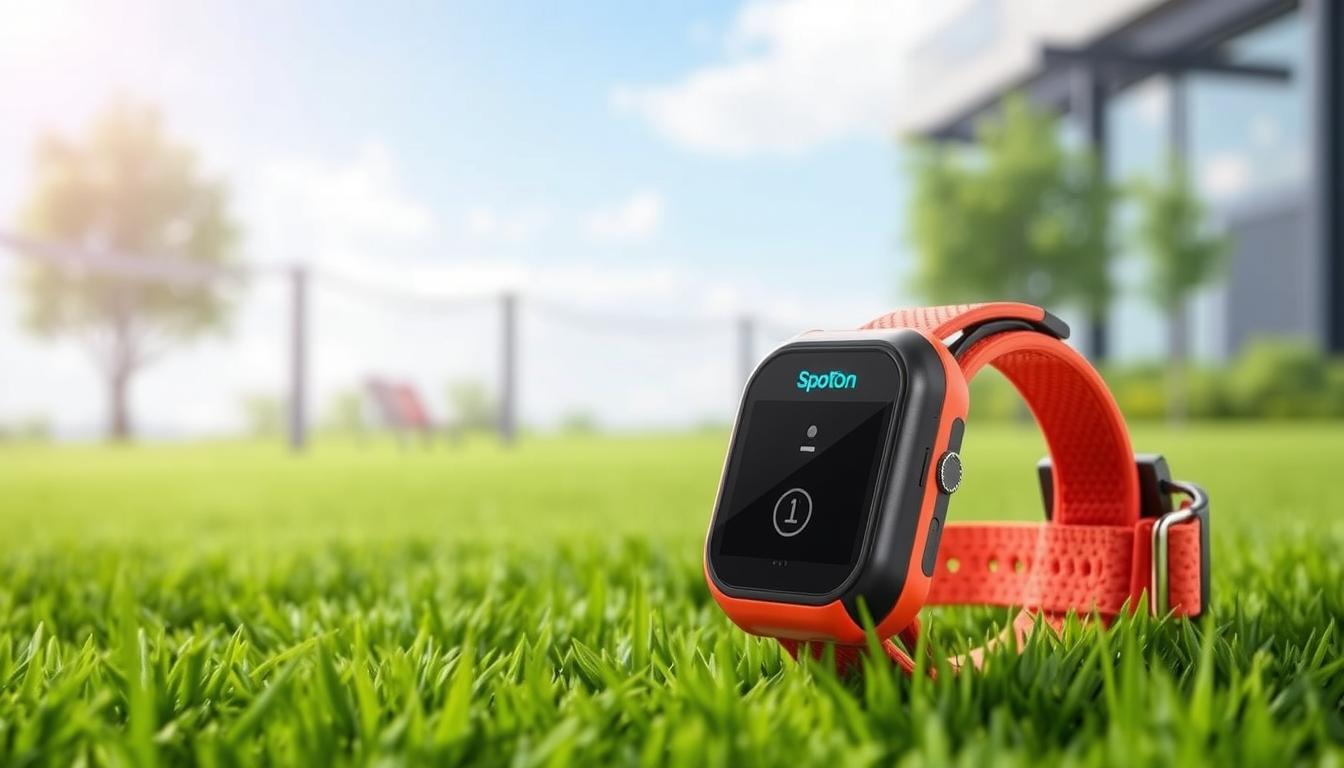
As a leading GPS dog fence system, the SpotOn GPS Fence Collar offers advanced features for enhanced pet safety. This premium GPS dog fencing solution remains a top contender in the market despite strong competition.
Overview
The SpotOn GPS Fence Collar is designed with patented True Location™ GPS technology, which improves accuracy and provides reliable boundary alerts. It also features Forest mode, enhancing GPS reception in heavily wooded areas, ensuring your dog’s safety regardless of the environment.
Key Features
This GPS dog fence system allows you to create and store unlimited unique fences covering areas from 0.5 acres up to thousands of acres. You can draw boundaries directly on the app, making it highly customizable. The “Keep Out zones” feature lets you designate areas within your property where your dog shouldn’t go with just a swipe of your finger.
Pros
The SpotOn GPS Fence Collar boasts 30 levels of static correction, twice as many as many competitors, providing a more nuanced training experience. It can be used as an invisible fence without a subscription, and it recharges quickly in just one hour. The battery life is impressive, lasting up to 40+ hours depending on usage.
Cons
Despite its many advantages, the SpotOn GPS Fence Collar is the priciest option overall, and it requires a subscription for GPS tracking features. It’s not suitable for small-breed dogs due to its size, and there’s a minimum yard size requirement of 1/2 acre.
In conclusion, the SpotOn GPS Fence Collar is a robust GPS dog fencing solution that offers flexibility and advanced features. While it may come with a higher price tag and some limitations, its benefits make it a worthwhile investment for many dog owners.
Tractive GPS Tracker (Budget Option)
![]()
For pet owners on a budget, the Tractive GPS Tracker offers an affordable alternative to traditional GPS fence systems. While it may not be a true GPS fence in the same league as brands like Halo and SpotOn, it provides many similar features at a fraction of the cost.
Device Overview
The Tractive GPS Tracker is designed to be versatile and user-friendly. It can be attached to nearly any collar, making it a convenient option for dog owners who already have a preferred collar. The device serves not only as a GPS tracking device but also as an activity monitor that tracks your dog’s sleep patterns, providing valuable insights into their overall health and behavior.
Key Device Features
The Tractive GPS Tracker allows you to set up five GPS barriers that can be designated as either safe zones or no-go zones for your dog. This feature provides some level of containment functionality, helping to ensure your dog stays within designated areas. The device comes in two sizes: the original Tractive is suitable for dogs weighing 9+ lbs, and there’s an XL model designed for breeds weighing 40+ lbs. Both models boast 100% waterproof construction, ensuring durability and reliability.
Advantages
The Tractive GPS Tracker has several advantages, including its incredibly affordable price compared to dedicated GPS fence systems. It also boasts impressive battery life, with the standard model lasting up to 10 days on a single charge and the XL model extending that to a month. Additionally, the device is lightweight, weighing just 3.2oz. Other benefits include family sharing options, allowing multiple users to track the same pet, and a Live mode feature that provides location updates every 2-3 seconds.
Limitations
Despite its many benefits, the Tractive GPS Tracker has some limitations. For instance, it requires a subscription to use any of its features, which may be a drawback for some users. Moreover, it cannot actively prevent dogs from leaving designated boundaries, relying instead on alerts and notifications. There’s also the potential for limited coverage in some areas, which could impact its effectiveness.
Setting Up Your GPS Dog Fence System
Setting up your GPS dog fence system is the first step towards giving your dog the freedom to roam while keeping them safe. The process is designed to be straightforward, allowing you to quickly secure your pet.
Initial Setup Process
The initial setup involves downloading the associated app and creating your first virtual boundary. You can either walk the perimeter with the collar to create the boundary in real-time or draw it directly on the app’s map interface. This flexibility is particularly useful for those with mobility issues. After setting the boundary, it’s crucial to test the system to ensure accuracy and adjust correction levels as needed.
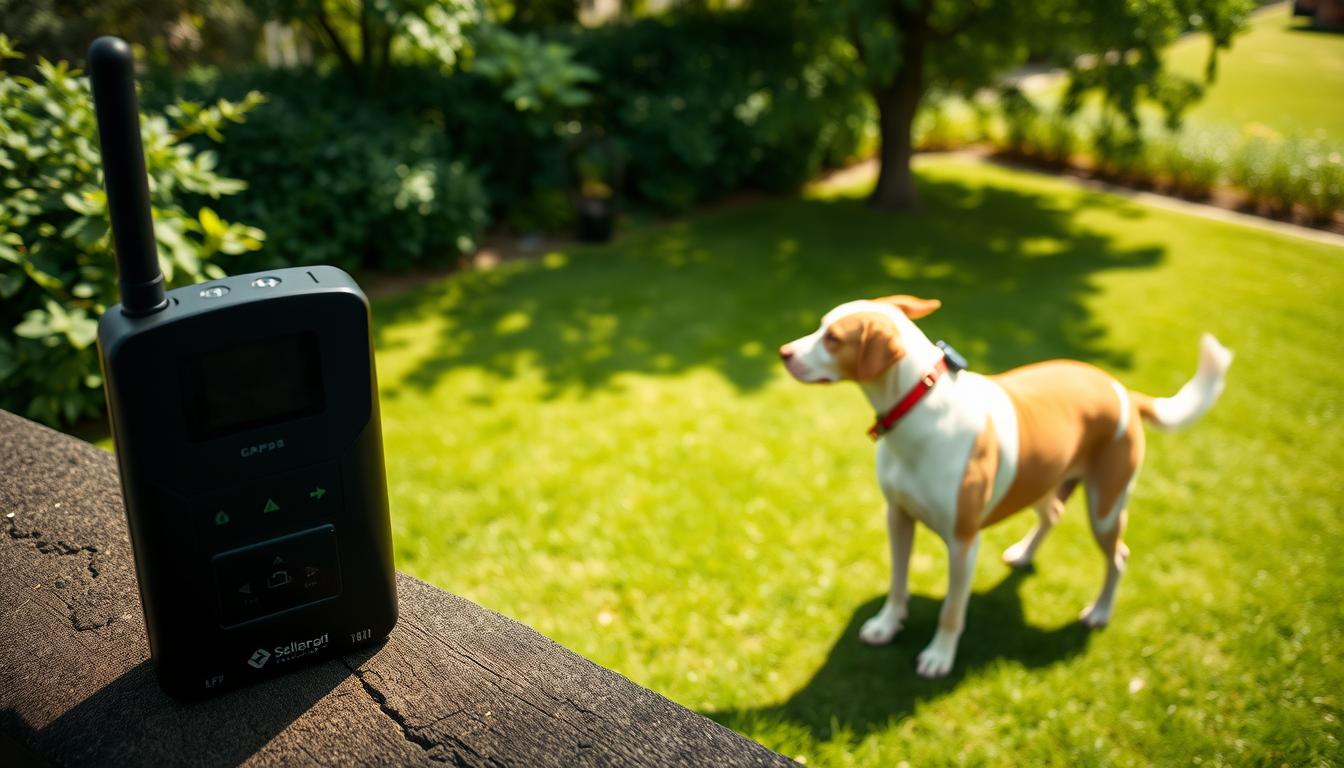
Training Your Dog to Recognize Boundaries
Training your dog to respect the virtual boundaries is a gradual process that starts with visual markers and positive reinforcement. Begin by introducing your dog to the flagged boundaries and rewarding them for staying within the designated area. As your dog becomes more comfortable, you can gradually introduce the correction features. Consistency and patience are key, as this training typically takes 2-3 weeks. Be prepared to address any challenges that arise, such as stubbornness or fearfulness, by adjusting your training approach as needed.
Combine GPS Tracking with Wireless Dog Fence for Maximum Security
To ensure maximum security for your dog, consider combining GPS tracking with a wireless dog fence. This integrated system not only contains your pet within designated boundaries but also enables you to locate them if they escape.
Creating Multiple Boundaries
One of the key benefits of combining GPS tracking with wireless dog fencing is the ability to create multiple boundaries for different scenarios. For instance, you can set up a home boundary, a boundary for your vacation property, and even temporary boundaries when traveling. This flexibility is particularly useful for dogs that accompany their owners on various adventures.
Moreover, within your property, you can establish nested boundaries to keep your dogs away from specific areas such as pools, gardens, or driveways. This feature is especially valuable for preventing accidents and ensuring your dog’s safety.
Real-Time Tracking Benefits
The real-time tracking benefits of GPS dog fences allow you to monitor your dog’s location within the set boundaries and receive instant alerts if they approach or cross the perimeters. This capability is crucial for quickly responding to potential escape attempts and preventing loss or accidents.
Furthermore, real-time tracking data can help you identify patterns in your dog’s behavior, enabling you to adjust boundaries or training strategies accordingly. For dogs with specific behavioral issues, such as fence-jumping or chasing wildlife, this combined system offers an additional layer of security and peace of mind.
Subscription Plans and Costs
Understanding the costs associated with GPS dog fence systems is crucial for making an informed decision. When investing in a GPS dog fence, you need to consider not only the initial hardware cost but also the ongoing subscription fees.
Monthly vs. Annual Plans
GPS dog fence systems typically offer both monthly and annual subscription plans. Monthly plans can range from $7.99 to $29.99, while annual plans often come with significant discounts, making them a more cost-effective option in the long run. For instance, opting for a 2-year subscription can be almost half the price of a month-to-month plan, offering substantial savings.
What’s Included in Different Tiers
Different subscription tiers offer varying levels of features. Basic plans usually cover essential GPS tracking, while premium plans may include additional features like real-time tracking, multiple pet tracking, and advanced alerts. Some systems also offer family plans that allow tracking multiple pets under one subscription at a discounted rate. It’s essential to review what’s included in each tier to determine which plan best suits your needs.
Troubleshooting Common GPS Fence Issues
GPS fence issues can be frustrating, but most problems have simple solutions. Understanding how to troubleshoot these issues can help you maintain the effectiveness of your GPS fence and ensure your pet’s safety.
Signal Interference Problems
Signal interference can cause your GPS fence to malfunction. Common causes include dense tree coverage, buildings, and electronic devices that disrupt the GPS signal. To resolve this, try to:
- Reposition the GPS device to improve signal reception
- Avoid areas with high electronic device density
- Adjust the sensitivity settings to compensate for interference
Battery and Charging Issues
Battery life and charging problems are common issues with GPS fences. To maximize battery life:
| Best Practice | Benefit |
|---|---|
| Charge the device regularly | Prevents unexpected shutdowns |
| Avoid extreme temperatures | Prolongs battery lifespan |
| Update software regularly | Ensures optimal performance |
If you’re experiencing charging issues, check the charging port for debris and try using a different charger.
Future of GPS Pet Systems
The future of GPS pet systems is rapidly evolving with advancements in technology. As we look ahead, several key trends are emerging that will shape the industry.
Emerging Technologies
New technologies are being integrated into GPS pet systems, including more accurate positioning systems and longer-lasting power solutions. Artificial intelligence and machine learning are being used to better predict pet behavior and improve containment effectiveness. Additionally, the trend toward miniaturization will make GPS tracking devices more suitable for smaller pets and more comfortable for all animals.
Integration with Smart Home Systems
GPS pet systems are beginning to integrate with smart home ecosystems, allowing for automated responses when pets enter or leave designated areas. This integration could also enable features like health monitoring, alerting owners to unusual activity patterns that may indicate health issues. Furthermore, voice control through smart assistants may simplify the management of pet containment systems.
Conclusion
Combining GPS tracking with wireless dog fencing offers a cutting-edge approach to ensuring your dog’s safety and your peace of mind. This integrated system provides both preventative containment and reactive tracking capabilities, surpassing traditional fences. Top-recommended systems like Halo Collar4 and Tractive cater to different needs and budgets. Proper setup and training are crucial to maximize effectiveness. As technology evolves, these systems will continue to provide better pet safety solutions. Consider your specific needs, property, and dog’s temperament when selecting a GPS fence system to ensure ultimate pet safety and containment.
FAQ
How do GPS pet systems work?
GPS pet systems use a collar that receives GPS signals to determine your pet’s location, and a base station or app to set boundaries and receive alerts.
What is the difference between a GPS dog fence and a traditional fence?
A GPS dog fence is a virtual fence that uses GPS signals to keep your dog within a set boundary, whereas a traditional fence is a physical barrier.
How long does the battery last on a GPS dog collar?
Battery life varies depending on the device and usage, but most GPS dog collars last between 1-5 days on a single charge.
Can I customize the boundaries for my GPS dog fence?
Yes, most GPS dog fence systems allow you to set custom boundaries and adjust them as needed.
How accurate is GPS tracking for pets?
GPS tracking for pets is generally accurate to within a few feet, depending on the device and satellite signal strength.
What happens if my dog escapes or wanders off?
If your dog escapes or wanders off, you’ll receive alerts on your phone or base station, allowing you to quickly locate and retrieve your dog.
Are GPS dog fences suitable for all dog sizes and temperaments?
Yes, GPS dog fences can be used for dogs of all sizes and temperaments, but it’s essential to choose a system that’s suitable for your dog’s specific needs.
Can I use a GPS dog fence in areas with poor GPS signal?
While GPS dog fences rely on a strong GPS signal, some systems offer alternative technologies, such as cellular or Wi-Fi connectivity, to help maintain coverage in areas with poor GPS signal.
How much do GPS dog fence systems cost?
The cost of GPS dog fence systems varies depending on the brand, features, and subscription plans, but you can expect to pay between -0 for the device and – per month for subscription fees.
Do I need a subscription for my GPS dog fence?
Most GPS dog fence systems require a subscription to access features like GPS tracking, boundary setting, and alerts.


